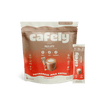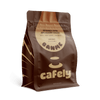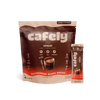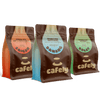For many, cutting coffee out of their diet means losing an important part of their routine. However, certain medications, like meloxicam, can have side effects that make drinking coffee impossible.
Medical professionals might not have the time to explain why we must cut something out of our diet, but understanding why we must change can make things easier. Here, we will explain why you can’t drink coffee when taking meloxicam and what you can do about it.
What Is Meloxicam?
Meloxicam is a common NSAID (non-steroidal anti-inflammatory drug) used to treat pain and inflammation. It targets pain by reducing inflammation, which typically leads to a reduction in pain levels.
Usually, meloxicam is given to those with different forms of arthritis to relieve symptoms like inflammation, swelling, stiffness, and joint pain. It’s important to remember that the medication doesn’t actually cure the underlying arthritis but rather makes the symptoms more manageable.
Meloxicam is most commonly given as a tablet, but it can also be found as a capsule, suspension, or dissolving tablet if the patient prefers. While it’s typically prescribed to adults, doctors also use it to treat juvenile rheumatoid arthritis. This broad age range is likely one of the reasons the medication is available in many formats.
Potential Side Effects of Meloxicam
Meloxicam does have some side effects, though even the most common ones are rare across the total number of people taking the drug. Here are a few notable side effects:
Common Side Effects of Meloxicam:
- Constipation
- Diarrhea
- Headaches
- Nausea
Uncommon Side Effects of Meloxicam:
- Anemia
- Burping
- Dizziness
- Skin reactions
Rare Side Effects of Meloxicam:
- Confusion
- Decrease in fertility in AFAB patients
- Photosensitivity reaction
Doctors are well aware of the side effects of different medications, and they would only prescribe you something if the benefits outweigh the risks. If you have any concerns about meloxicam, speak with your doctor.
Why Can’t I Drink Coffee with Meloxicam?
For most people, mixing coffee and meloxicam is safe. However, your doctor may advise you not to do so.
There are three main reasons why this may be the case:
- Stomach Irritation — Meloxicam is an NSAID — these drugs can disrupt the stomach lining [1]. While coffee doesn’t do this, it can lead to complications if this disruption has already occurred [2]. Together, they can lead to serious stomach irritation.
- Caffeine Interaction — Caffeine may bind with the meloxicam while it’s in your bloodstream. This would prevent the drug from interacting with your system as it should [3].
- Side Effect Aggravation — Some side effects of meloxicam include nausea, heartburn, and dizziness. If coffee already causes these symptoms in you, combining the medication with it could make them even worse.
The Science Behind Stomach Irritation
The stomach lining is a protective barrier between the contents of your stomach and the muscles surrounding the organ. Essentially, it's a flexible layer of tissue that produces enzymes and acids to aid digestion.
If you take NSAIDs over a long period or take them on an empty stomach, they can disrupt this lining. When this disruption happens, the contents come into contact with the stomach wall, which can lead to ulcers developing.
The actual reaction that causes ulcers comes down to the acidity of the stomach contents, so opting for low-acid coffee, such as cold brew, is wise. High-caffeine coffee has been shown to increase the overall production of acid, so switching to decaf may also be wise [2].
Meloxicam and Caffeine
Caffeine may interact with meloxicam, binding together to improve pain reduction [3]. However, because both NSAIDs and coffee can cause stomach irritation, it’s not wise to deliberately combine them repeatedly.
What Other Medication May Interact With Coffee?

Coffee is a chemically complex substance, with the average cup containing around 140 chemicals overall. However, most of these chemicals won’t interact with you or your medication. However, there are rare cases where the compounds in coffee do interact with medication.
Here are a few common examples:
1. Psychiatric Medication
In the case of psychiatric medication, caffeine is a chemical that doctors often warn to be wary of. At the most basic level, it can lead to or worsen symptoms of the condition that a medication aims to treat.
For instance, symptoms of chronic anxiety may include heightened awareness and jitters. Symptoms of drinking a lot of caffeine are similar, meaning that drinking a lot of coffee may counteract the impact of the medication.
On a more scientific level, though, caffeine is processed by a specific enzyme — CYP1A2 [4]. This common enzyme is what many psychiatric medications aim to interact with. If you drink a lot of caffeine, it may bind with the CYP1A2 before the medication gets a chance to.
In this way, caffeine can interact with lots of different antidepressants, antipsychotics, and antianxiety medications. If you have concerns about how caffeine may interact with any medication, always consult your doctor — they will help you find the best solution for your body and your lifestyle.
2. Thyroid-Boosting Medication
The thyroid is an important gland responsible for making and releasing many different hormones. In some people, the thyroid may not be as active — a disorder known as hypothyroidism. People with hypothyroidism can experience weight gain, dry skin, and joint pain, among other things. To help treat these symptoms, doctors may prescribe thyroid-boosting drugs such as levothyroxine.
Studies have found that drinking coffee while taking these thyroid-boosting medications may cause them to be less effective. Coffee reduces how much medicine is absorbed into your body, making it less impactful [5]. This impact isn’t small, either — a study found that coffee may reduce the absorption of thyroid medication by more than half [6].
3. Stimulants in Cold or Allergy Medication
The caffeine in coffee is a stimulant. It’s long been used to give the drinker a feeling of increased alertness, mental clarity, and a pleasant energy boost. However, when this stimulant is combined with others, it can lead to too much of a boost to the system.
In particular, cold and allergy medication often contains stimulants that target the central nervous system — the most common of these is pseudoephedrine [7]. When combined, it could lead to increased heart rate and blood pressure.
If you’re concerned about interactions between caffeine and other medications that may contain stimulants, always speak with your doctor for advice tailored to you.
How Does Coffee Interact With Your Body?
Coffee can interact with your body in a variety of different ways. The main component of coffee that has been shown to impact your system is caffeine.
Here are two main ways that coffee interacts with your body:
Caffeine and Adenosine
Caffeine works as a stimulant in your system by binding with certain chemical receptors, creating the illusion of boosting energy when, in reality, it simply blocks you from feeling tired [8].
Ordinarily, your body produces adenosine, which binds with receptors to make you feel sleepy. When you drink coffee and other caffeinated beverages, the caffeine gets to the same receptors first, so the adenosine never gets a chance to make you feel sleepy.
When you’re tired, and a cup of coffee wakes you up, you’re not getting any more energy. Instead, you’re delaying the feeling of sleepiness, leading to the illusion of wakefulness. Therefore, when the caffeine eventually wears off in your body, you’ll return to that feeling tired or even more tired.
Coffee and Digestion
When you drink coffee, you may have noticed that you need to poop shortly afterward. This reaction happens to a number of people, and it happens for two main reasons.
Firstly, coffee stimulates the body’s digestive secretions, whether from the stomach, biliary glands, or pancreas [9]. This pairs with a boost in the peristaltic movement of the small intestines and colon, leading to the whole “conveyor belt” moving along a little faster. It’s also thought that gastrin, a hormone stimulated by coffee, could add to this overall effect.
Secondly, we come to the gastrocolic reflex. This is the main reason you might need to visit the bathroom immediately after drinking coffee — our bodies associate certain triggers and stimuli with going to the bathroom. Since many people drink coffee and go to the bathroom in the morning, it’s only natural that the two might become linked.
The gastrocolic reflex is already active in the morning and increases movement in the intestines and colon. Regular stimuli, like drinking coffee first thing in the morning, may boost this reflex.
How To Lessen The Impact of Coffee

Coffee's impact on your system can be intense, especially if you're already experiencing side effects from different medications. Thankfully, now that we have more research on our side, we can manage how we interact with coffee to make the impact on our system easier.
1. Drink Decaf
The caffeine in your regular coffee may interact with the meloxicam itself and exacerbate any side effects of the medication. Therefore, reducing your caffeine intake can be a simple way to manage any symptoms you may experience. Most notably, decaf coffee could reduce any feelings of nausea, heartburn, or dizziness that meloxicam and caffeine together can cause.
If you choose not to switch your coffee to decaf, you could still moderate your caffeine intake. A good way to do this could be to have fewer cups of coffee per day or switch to a coffee that’s less caffeine-packed. For instance, swapping to arabica beans from robusta beans can reduce caffeine intake, leading to a potentially more straightforward time.
2. Opt for Cold Brew
Acidic drinks like coffee can increase the overall acidity of your stomach's contents. To make your coffee less acidic, consider switching to cold brewing — a slow cold-extraction brewing process that produces low acidity coffee.
However, high amounts of caffeine have been shown to stimulate the release of stomach acid [2]. Cold brew can be high in caffeine, so drink it cautiously if you’re concerned about stomach irritation.
To manage the caffeine in your cold brew, consider diluting it with milk or making a drink inspired by traditional Vietnamese iced coffee by adding condensed milk. Doing this will create a drink that’s the same volume as a regular coffee but has a little less caffeine.
3. Stay Hydrated
Making sure to stay hydrated is always wise when you’re taking any new medication. A well-hydrated body can help any medication to take effect more easily, and hydration can also reduce any symptoms of nausea or dizziness that meloxicam or caffeine may be causing.
On top of this, being hydrated will dilute your stomach's contents, making any irritation of the stomach lining slightly less likely to occur.
FAQs: Why Can’t I Drink Coffee with Meloxicam?
Now that we’ve gone through the science of interactions between meloxicam, coffee, and you, let’s discuss some FAQs.
1. What Happens if You Drink Coffee While Taking Meloxicam?
For most people, drinking coffee while taking meloxicam is perfectly safe. However, if you’re at a higher risk for stomach irritation or if you’re experiencing side effects of the medicine, such as nausea or dizziness, your doctor may advise you to reduce your coffee intake.
2. Should You Drink a Lot of Water with Meloxicam?
Because meloxicam is a type of medication called an NSAID (non-steroidal anti-inflammatory drug), it can cause some stomach irritation — especially if taken on an empty stomach. Therefore, it’s commonly recommended that you take the medication with a whole glass of water. However, if your doctor tells you otherwise, always follow their advice.
3. How Long Should I Wait to Take Medicine After Drinking Coffee?
Sometimes, tannins in coffee can interact with medication and decrease the rate at which they’re absorbed. To prevent this issue, it may be worth waiting one to two hours after coffee to take your medication.
4. What Supplements Cannot Be Taken with Meloxicam?
There are several supplements you should avoid taking with meloxicam — the drug has a long list of other compounds with which it interacts. If you’re concerned about any supplements you’re taking, speak with your doctor, who will give you personalized advice.
5. Can I Drink Coffee While Taking an Anti-Inflammatory?
Most of the time, it’s perfectly safe to drink coffee while taking anti-inflammatory medications. An issue can arise if the anti-inflammatories lead to gut irritation, which caffeine may exacerbate by stimulating the release of stomach acid [2].
6. What Organ is Meloxicam Hard On?
Meloxicam can impact the liver. However, your doctor has likely considered this and has only prescribed meloxicam because they’re confident in your body’s reaction to the medication. If you have concerns about your liver, consult a medical professional.
7. What Foods Should You Avoid While Taking Meloxicam?
When taking meloxicam, it’s important to avoid grapefruits or other acidic fruits and vegetables. These can worsen the drug's side effects.
8. Does Meloxicam Make You Pee At Night?
One of the known side effects of Meloxicam is that it may make you pee more frequently, including during the night. If this happens to you, consult your doctor about switching to a different medication.
9. Does Meloxicam Help with Pain or Just Inflammation?
Meloxicam can help with both inflammation and general pain. Most of the pain that people experience is due to inflammation to some degree, so lots of anti-inflammatories may help to reduce general pain [10].
10. Does an Empty Stomach Mean No Coffee?
Taking medication on an empty stomach might seem a little hard to define. A good rule of thumb is that an empty stomach contains no solid food or opaque liquids. Following that rule will mean that you’re drinking mostly water (even in the case of black tea or coffee), which is typically okay for most medications. If you have concerns, always consult your doctor.
References
- Lipscomb GR, Wallis N, Armstrong G, Rees WD. Gastrointestinal tolerability of meloxicam and piroxicam: a double-blind placebo-controlled study. Br J Clin Pharmacol. 1998 Aug;46(2):133-7. doi: 10.1046/j.1365-2125.1998.00761.x. PMID: 9723821; PMCID: PMC1873665.
- Acquaviva, F., DeFrancesco, A., Andriulli, A., Piantino, P., Arrigoni, A., Massarenti, P., & Balzola, F. (1986). Effect of regular and decaffeinated coffee on serum gastrin levels. Journal of Clinical Gastroenterology, 8(2), 150–153.
- SYROVA, A., LUKYANOVA, L., KOZUB, S., ZAVADA, O., LEVASHOVA, O., & SHAPOSHNIK, V. (2020). Investigation of the Peripheral Analgesic Activity of Oxicams and Their Combinations with Caffeine. Turkish Journal of Pharmaceutical Sciences, 17(4), 408.
- Broderick, P. J., Benjamin, A. B., & Dennis, L. W. (2005). Caffeine and psychiatric medication interactions: a review. The Journal of the Oklahoma State Medical Association, 98(8), 380–384
- Benvenga, S., Bartolone, L., Pappalardo, M. A., Russo, A., Lapa, D., Giorgianni, G., Saraceno, G., & Trimarchi, F. (2008). Altered intestinal absorption of L-thyroxine caused by coffee. Thyroid : official journal of the American Thyroid Association, 18(3), 293–301.
- Belayneh, A., & Molla, F. (2020). The Effect of Coffee on Pharmacokinetic Properties of Drugs : A Review. BioMed Research International, 2020, 7909703.
- Głowacka, K., & Wiela-Hojeńska, A. (2021). Pseudoephedrine—Benefits and Risks. International Journal of Molecular Sciences, 22(10), 5146.
- Institute of Medicine (US) Committee on Military Nutrition Research. Caffeine for the Sustainment of Mental Task Performance: Formulations for Military Operations. Washington (DC): National Academies Press (US); 2001. 2, Pharmacology of Caffeine.
- Iriondo-DeHond, A., Uranga, J. A., del Castillo, M. D., & Abalo, R. (2021). Effects of Coffee and Its Components on the Gastrointestinal Tract and the Brain–Gut Axis. Nutrients, 13(1), 88.
- Omoigui S. (2007). The biochemical origin of pain: the origin of all pain is inflammation and the inflammatory response. Part 2 of 3 - inflammatory profile of pain syndromes. Medical hypotheses, 69(6), 1169–1178.










